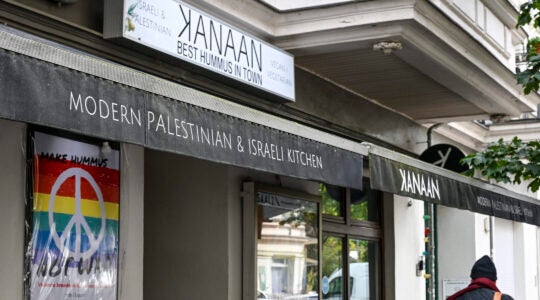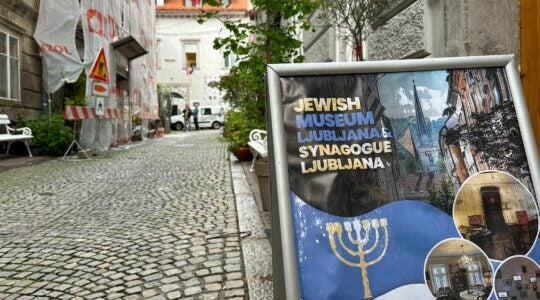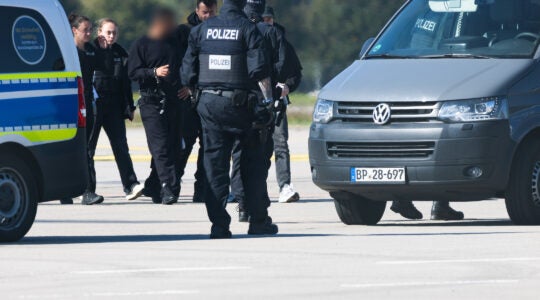
Participants celebrating during services at the World Union for Progressive Judaism Conference of Jewish Communities in Buenos Aires, Argentina, Aug. 2012. (Diego Melamed)
BUENOS AIRES, Argentina (JTA) — When the Sao Paulo Hebraica Sports Club and Community Center in Brazil opened the Aleph School earlier this month, it welcomed 450 students and had 120 more on the waiting list for next year.
Hebraica, which is similar to an American Jewish community center, has reached 24,000 members and has a $30 million budget. Meanwhile, Sao Paulo’s oldest synagogue, Temple Beth El, recently dedicated a new building, leaving the original one to become the Jewish Museum of Sao Paulo.
In Panama, the Jewish community has grown by 70 percent in the past 10 years. The 8,000-member community in that period has seen a rise from three to 10 b’nai mitzvah a week.
In Argentina, the number of children in Jewish preschool programs has soared by nearly 1,000 — from 3,952 in 2005 to 4,914 in 2012.
Nearly wherever one looks, Jewish life is growing in Latin America, which is now home to an estimated 500,000 Jews. The growth comes as the region continues to transform economically as part of a social evolution following the end of military dictatorships that ruled many countries into the 1980s.
From 2000 to 2010, poverty in the region dropped from 44 percent to 32 percent of the population, according to the Economic Committee for Latin American and the Caribbean, or CEPAL. In large part it is because of the increase in jobs that has come from rising prices for the region’s commodities and natural resources, such as copper, oil, soybeans, meat, fruits and other agricultural products.
And more growth is on the horizon. Latin America will contribute to global growth more than Europe in the next seven years, according to CEPAL, which released a study in August that said the 2013-2020 period “will be a low-growth cycle for industrialized economies while it will display dynamism in emerging economies.”
Despite the growth, challenges remain for many Jewish communities.
“We have strong signals of a new flourishing situation, but we also will still have a variety of problems, like the poor knowledge about Judaism in our members and some type of hidden anti-Semitism in the general society,” said Alberto Milkewitz, director of the Isaraelite Federation of Sao Paulo.
But that hasn’t dimmed optimism among Jewish leaders.
Some 83 percent of approxiately 400 of the region’s Jewish leaders polled recently by the American Jewish Joint Distribution Committee believe that conditions in their countries are good enough to further develop Jewish life. Only 10 percent reported that living as a Jew is risky. Brazilians self-reported the most positive feedback, Venezuelans the most negative. The poll’s full results will be released at the Nov. 12 JDC meeting of Latin American and Caribbean Jewish community leaders, which will convene in Quito, Ecuador.
Venezuela is the notable exception to the wave of positivity among Latin American Jewish communities. Political insecurity, economic challenges and state-sponsored anti-Semitism in the country have prompted significant Jewish emigration in recent years, with most expats moving to the United States, Israel, Spain, Colombia or Panama. Venezuela now has an estimated 9,000 Jews, down from about twice that number a decade ago, according to the JDC.
The race for president in Venezuela has seen the incumbent, Hugo Chavez — a close ally of Iran and acerbic critic of Israel — use state media to lob anti-Semitic broadsides against his rival, Henrique Capriles Radonski, a grandson of Holocaust survivors who identifies as Catholic. The election is scheduled for Oct. 7.
In Chile, home to 15,000 Jews among a Palestinian Diaspora as large as 400,000, Rabbi Chaim Koritznisky is much more positive.
“Four years ago I was invited to Santiago by five families to build a new synagogue community called Ruach Ami,” said Koritznisky, who heads a Reform congregation. “The founders felt that there was a void in the Jewish community for those searching for a Judaism that was egalitarian, inclusive, spiritual. We also offer a welcoming home for interfaith couples and families, gays and lesbians.”
A hundred families now belong to the temple and more than 500 people are expected to arrive for the coming High Holidays services.
Also in Santiago, the Dr. Chaim Weizmann Hebrew Institute has seen sustained growth. In 2005 there were 265 children aged 2 to 5 in the preschool. Today the number is at 373, according to Sergio Herskovitz, the school principal.
Similar stories in the region abound. In Panama City, a decade ago there were barely any children at weekly activities at Kol Shearith Israel synagogue. Now nearly 60 young people participate in weekly events and the total budget of the community has tripled.
The community has been strengthened in part by Jewish immigrants from Venezuela and even Argentina and Uruguay, says Gustavo Kraselnik, the rabbi of Kol Shearith Israel.
“We are very optimistic about our future,” he said.
Argentina, with 285,000 Jews, is home to the region’s largest Jewish community. The growth in preschool children there has been matched by a rise in Jewish high school and college students. In Buenos Aires alone the number has risen from 15,593 to 19,162 in the past seven years.
In the capital city, the economic recovery allowed real estate developments such as Nordelta, a gated community with artificial lakes, to erect a new Jewish center two years ago. Last Chanukah, about 150 people came out for a celebration.
“We started from zero,” Rabbi Diego Elman of Judaica Fundation, the Nordelta temple, told JTA. “This year we started a monthly Shabbat with an average of 60 people; most of them are children.”
The growth also has brought the need for more Jewish teachers. In 2006, a new training center to prepare Jewish teachers was opened in Buenos Aires. It’s had 35 graduates.
“It’s a good start, but there is a scarcity of teachers in every main city of the region,” said Leticia Baran, the supervisor of Argentina’s Department of Jewish Education. “We’re starting to export Jewish teachers to other countries.”
International Jewish organizations are noticing the increased Jewish activities. Last November the ROI Community, which convenes creative Jewish social entrepreneurs, celebrated an Ibero-American gathering in Buenos Aires to “propel the Latin American Jewish spring” and to spotlight the region’s “dynamic Jewish social entrepreneurs.”
The same month, the Jewish Agency’s board of governors met in Argentina — the first time in 15 years that its summit was held outside of Israel. The following month, Jewish Agency Chairman Natan Sharansky announced a $1 million fund to strengthen the connection between young South American Jews to Israel and the global Jewish community. And last December, Bnai B’rith International held its International Policy Conference in Montevideo, Uruguay — the first time the international event was held in Latin America.
“This region has a vibrant reality and an incredible production of knowledge and Jewish life,” Shai Pinto, the vice president and COO of the World Union for Progressive Judaism, told JTA. “In our movement Latin America is the fastest growing region.”
Fabian Triskier, the JDC’s Latin America director, says, “Our conclusion is clear: The Jewish community of Latin America is moving forward.”
JTA has documented Jewish history in real-time for over a century. Keep our journalism strong by joining us in supporting independent, award-winning reporting.





